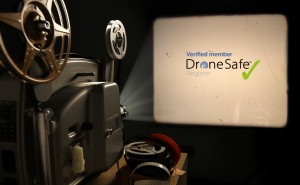
To operate legally as a commercial drone pilot in the UK you must take some formal training.

A drone course you can attend in person is by far the best option as there’s nothing like hands on training where you can ask questions and learn from experts. Joining a drone pilot course is also a great opportunity to meet likeminded people and begin to develop your professional network.
The Civil Aviation Authority delegates the authority to grant permission to work as a commercial drone pilot in the UK to organisations with National Qualified Entity (NQE) status. To become an NQE a company goes through a rigorous assessment process to ensure its training is of the required standard.
The first stage of training to become a CAA authorised drone pilot is commonly referred to as ‘Ground School.’ It’s recommended that you do some pre-course reading before this as the terminology alone can be quite confusing if you’re not from an aviation background.
Don’t expect a drone training provider to teach you the mechanics of flying your aircraft – that’s your job! You should study your drone’s user manual before attending a course and clock up some flying time so you are able to perform basic take-off and landing and turning etc.
Don’t worry about flying at speed or carrying out complex manoeuvres – it’s all about safety and control. If you can control your drone to fly in a circle and progress to a figure of eight you’re at the level required.
Drone training providers must prepare you to fly safely and without breaking the law during the course for a PFCO. Some of the core elements you need to understand are the different types of airspace, UK Aviation or Air Law and how to read maps and charts.
If you understand the theory behind these you’re unlikely to put other aircraft at risk or fly in areas you shouldn’t.
Incredible as it sounds, some 6,000 aircraft fly above our heads in the UK every day. As well as leisure and cargo carrying flights there are also military and emergency services. By understanding Aviation Law and classes of air space a drone pilot can mitigate the risk of interfering with the invisible infrastructure in the sky. For obvious reasons, airspace around airports is strictly controlled.
That’s not to say drone pilots can’t operate in such areas, but they must work with local Air Traffic Control or other relevant authorities to ensure flight safety.
Human factors, meteorology and risk management are also covered by drone training providers. A pilot should never operate a drone if unwell or under the influence of alcohol for example. All aircraft are influenced by meteorological factors, and it’s particularly the case for drones.
Operating in high winds, fog or extreme temperatures should be avoided. Pilots are taught to carry out a risk survey at a location before each flight to ensure they have a safe area for take-off and landing. Roads, railway lines, pedestrian pathways and other features of a location must all be considered and steps taken to mitigate they risks they represent.
Once a pilot passes the theory test carried out by their drone training provider it’s time for the practical flight test.
This is similar to the process for obtaining a licence to drive a car – you must prove to examiners that you both know the theory of driving and how to actually control a car on the roads. A drone pilot flight test isn’t just about taking off, flying and landing. The examiner will check that’ve carried out a risk assessment of the flight area and understand potential hazards. During the test the examiner may want to simulate scenarios to test how you would react. For example, he may ask the pilot to imagine that a helicopter has appeared behind some trees in the distance. Once the aircraft is back on the ground you’ll need to prove you know what data to log and answer some questions.

The third stage of obtaining a PfCO is to prepare an Operations Manual.
This sets out in detail the type of drone you will use and how you will manage the day to day operation of your drone business. It can be daunting at first as it’s a technical document, but good drone training providers provide templates and guide you through the process. Once submitted to and approved by the CAA a pilot receives their PfCO and is ready to operate commercially.
Some drone training providers also cover additional material during courses, such as marketing your drone business and finding work.
Demand for commercial drone pilots in the UK is growing, but it’s still a tough business to break into. Joining Drone Safe Register can help with this as membership includes listing on the quotation platform used by people looking to hire drone services.
Members also share work if there are jobs they’re unable to carry out, and it’s a thriving community for commercial drone pilots.

Drone Safe Register™ is a Recognised Professional Network of CAA approved professionals that offer services for aerial and ground video, film, photography and Drone Operators.
You can search using our no-obligation instant quote platform to find a local member that fits your requirements.
If you’re not a member already then there are many reasons to become a Drone Safe Register™ member. For more information, see the Membership page.


